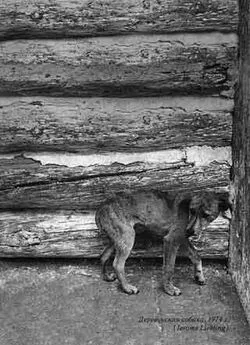Лорна Коппингер - Собаки. Новый взгляд на происхождение, поведение и эволюцию собак
- Название:Собаки. Новый взгляд на происхождение, поведение и эволюцию собак
- Автор:
- Жанр:
- Издательство:«СОФИОН»
- Год:2005
- Город:Москва
- ISBN:5-9668-0006-5
- Рейтинг:
- Избранное:Добавить в избранное
-
Отзывы:
-
Ваша оценка:
Лорна Коппингер - Собаки. Новый взгляд на происхождение, поведение и эволюцию собак краткое содержание
Авторы — супружеская чета Коппингеров — хорошо известны как среди специалистов по поведению животных, так и вне научных кругов — среди тех, кто занимается или интересуется собаками.
В книге обсуждаются:
— место собаки в истории человеческой цивилизации и его изменение в ходе истории от первобытных времен до наших дней;
— происхождение и эволюция собаки с объяснением форм, пород, биологического смысла породоспецифических особенностей;
— формирование специфического поведения собак различных пород с этологической и генетической точек зрения.
Как важное достоинство произведения следует отметить живой язык и своеобразный юмор авторов. Продемонстрировав нетривиальный научный анализ и несомненный литературный талант, авторы создали яркую и интересную книгу.
Предназначено для кинологов, этологов, экологов, антропологов, студентов ветеринарных факультетов и академий, а также для широкого круга читателей.
Собаки. Новый взгляд на происхождение, поведение и эволюцию собак - читать онлайн бесплатно полную версию (весь текст целиком)
Интервал:
Закладка:
110. Coppinger, R.P., С.К. Smith, and L. Miller. 1985. Observations on why mongrels may make effective livestock protecting dogs. Journal of Range Management 38 (6): 560—61.
111. Coren, Stanley. 1994. The Intelligence of Dogs. New York: Bantam Books.
112. Eisenberg, J.F., and Paul Leyhausen. 1972. The phylogenesis of predatory behavior in mammals. Zeitschrift fur Tierpsychologie 30: 59—93.
113. Fox, M.W. 1969. Ontogeny of prey-killing behavior in Canidae. Behavior 35 (18): 259—70.
114. Freedrnan, D.G. 1958. Constitutional and environmental interactions in rearing of four breeds of dogs. Science 127: 585—86.
115. Hahn, Martin E., and John С Wright. 1998. The influence of genes on social behavior of dogs. In Genetics and the Behavior of Domestic Animals, edited by T. Grandin. San Diego: Academic Press.
116. Hall, W.G., and Christina L. Williams. 1983. Suckling isn't feeding, or is it? A search for developmental continuities. Advances in the Study of Behavior 13: 219—55.
117. Hirsch, Jerry. 1964. Breeding analysis of natural units in behavior genetics. American Zoologist 4: 139—45.
118. Klinghammer, Erich. 1976. Wolf ethogram — abbreviations and definitions. Battle Ground, Ind.: Wolf Park.
119. Mahut, Helen. 1958. Breed differences in the dog's emotional behaviour. Canadian Journal of Psychology 12 (1): 35—44.
120. McConnell, R.A., and J.R. Bayliss. 1985. Interspecific communication in cooperative herding: Acoustic and visual signals from human shepherds and herding dogs. Zeitschriftfur Tierpsychologie 67: 303—28.
121. Moore, George, and Theresa Moore. 1976. Herding instincts, trials and your stock dog. The World of the Working Dog 2 (4): 14—19.
122. Vincent, Louis E., and Marc Bekoff. 1978. Quantitative analyses of the ontogeny of predatory behaviour in coyotes, Canis latrans. Animal Behaviour 26: 225—31.
Глава 7
123. Bateson, Patrick. 1991. Assessment of pain in animals. Animal Behaviour 42: 827—39.
124. Beck, Alan M. 1973. The Ecology of Stray Dogs: A Study of Free-ranging Urban Animals. Baltimore: York Press.
125. Beck, Alan, and Aaron Katcher. 1996. Between Pets and People. West Lafayette, Ind.: Purdue University Press.
126. Blaisdell, John D. 1999. The rise of man's best friend: The popularity of dogs as companion animals in late eighteenth century London as reflected by the dog tax of 1796. Anthrozoos 12 (2): 76—87.
127. Borchelt, Peter L., and Victoria L. Voith. 1982a. Classification of animal behavior problems. Veterinary Clinics of North America: Small Animal Practice 12: 571—85.
— 1982b. Diagnosis and treatment of separation-related behavior problems in dogs. Veterinary Clinics of North America: Small Animal Practice 12: 625—35.
128. Brown, С J., O.D. Murphree, and E.O. Newton. 1978. The effect of inbreeding on human aversion in pointer dogs. The Journal of Heredity 69: 362—65.
129. Coppinger, Raymond. 1996. Fishing Dogs. Berkeley, Calif: Ten Speed Press.
130. Dawkins, Marian Stamp. 1988. Behavioural deprivation: A central problem in animal welfare. Applied Animal Behaviour Science 20: 209—25.
131. Dodman, Nicholas. 1996. The Dog Who Loved Too Much. New York: Bantam.
132. Elliot, Orville, and J.R. Scott. 1961. The development of emotional distress reactions to separation in puppies. The Journal of Genetic Psychology (99): 3—32.
133. Estep, Daniel Q. 1996. The ontogeny of behavior. In Readings in Companion Animal Behavior, edited by V.L. Voith and P.L. Borcheit. Trenton, N.J.: Veterinary Learning Systems.
134. Fisher, John. 1995. Understanding the Behaviour of the Pet Dog. Tisbury, Wiltshire, England: COAPE.
135. Freedman, D. G. 1958. Constitutional and environmental interactions in rearing of four breeds of dogs. Science 127: 585—86.
136. Freedman, Daniel G., John A. King, and Orville Elliot. 1960. Critical period in the social development of dogs. Science 133: 1016—17.
137. Hart, Benjamin L., and Lynette A. Hart. 1985. Selecting pet dogs on the basis of cluster analysis of breed behavior profiles and gender. Journal of the American Veterinary Medical Association 186 (11): 1181—85.
138. Hart, Benjamin L., and Michael F. Miller. 1985. Behavioral profiles of dog breeds. Journal of the American Veterinary Medical Association 186 (11): 1175—80.
139. Houpt, Katherine A. 1985. Companion animal behavior: A review of dog and cat behavior in the field, the laboratory and the clinic. Cornell Veterinary 75: 248—61.
140. Jones, Mitchell. 1988. The Dogs of Capitalism. Book I: Origins. Austin, Tex.: 21st Century Logic.
141. McCrave, Elizabeth. 1991. Diagnostic criteria for separation anxiety in the dog. Veterinary Clinics of North America: Small Animal Practice 21 (2): 247—55.
142. Radde, Glenn. 1980. The significance of the dog: Perspectives of dog human relationships. Masters, Department of Geography, University of Minnesota.
143. Serpell, James. 1986. In the Company of Animals. Oxford, UK: Basil Blackwell.
144. Thomson, Keith. 1996. The rise and fall of the English bulldog. American Scientist 84: 220—23.
145. Voith, Victoria, and Peter Borchelt. 1982. Diagnosis and treatment of dominance aggression in dogs. Veterinary Clinics of North America: Small Animal Practice 12 (4): 655—63.
146. Voith, Victoria L., and Peter L. Borchelt, eds. 1996. Readings in Companion Animal Behavior. Trenton, N.J.: Veterinary Learning Systems.
Глава 8
147. Allen, Karen, and Jim Blascovich. 1996. The value of service dogs for people with severe ambulatory disabilities. Journal of the American Medical Association 275 (13): 1001—06.
148. Baun, Mara M., Nancy Bergstrom, Nancy F. Langston, and Linda Thoma. 1984. Physiological effects of the human/companion animal bond. Nursing Research 33 (3): 126—29.
149. Coppinger, Raymond, and Justine Lyons. 1995. Wheelchair Assistance Dogs. Amherst, Mass.: Hampshire College.
150. Coppinger, Raymond, Lorna Coppinger, and Ellen Skillings. 1998. Observations on assistance dog training and use. Journal of Applied Animal Welfare Science 1 (2): 133—44.
151. Coppinger, R., and J. Zuccotti. 1999. Exercise and socialization in dogs. Journal of Applied Animal Welfare Science 2: 281—96.
152. Eddy, Jane, Lynette A. Hart, and Ronald P. Boltz. 1988. The effects of service dogs on social acknowledgments of people in wheelchairs. The Journal of Psychology 122 (1): 39—45.
153. Fuller, John L. 1960. Behavior gene tics. Annual Review of Psychology 11: 41—70.
— 1967. Experiential deprivation and later behavior. Science 158: 1645—52.
154. Gagnon, Sylvain, and Francois Y. Dore. 1992. Search behavior in various breeds of adult dogs (Canis familiaris): Object permanence and olfactory cues. Journal of Comparative Psychology 106 (1): 58—68.
155. Goddard, M.E., and R.G. Beilharz. 1982/83. Genetic traits which determine the suitability of dogs as guide-dogs for the blind. Applied Animal Ethology 9: 299—315.
1986. Early prediction of adult behaviour in potential guide dogs. Applied Animal Behaviour Science 15: 247—60.
156. Hart, Lynette A, Benjamin L. Hart, and Bonita Bergin. 1987. Socializing effects of service dogs for people with disabilities. Anthrozoos 1: 41—44.
157. Hart, Lynette A., R. Lee Zasloff, and Anne Marie Benfoatto. 1995. The pleasures and problems of hearing dog ownership. Psychological Reports 77: 969—70.
158. Hirsch, Jerry. 1990. A nemesis for heritability estimation. Behavioral and Brain Sciences 13 (1): 137—38.
159. Leighton, Eldin. 1997. Genetics of canine hip dysplzsia. Journal of the American Veterinary Medical Association 210 (10): 1474—79.
160. Mader, Bonnie, Lynette A. Hart, and Bonita Bergin. 1989. Social acknowledgments for children with disabilities: Effects of service dogs. Child Development 60: 1529—34.
161. Mitchell, Daniel S. 1976. Selection of Dogs for Land Mine and Booby Trap Detection Training. Fort Belvoir, Virginia: U.S. Army Mobility Equipment Research and Development Command.
162. O'Farrell, V. 1986. Manual of Canine Behaviour. Cheltenham, Gloucestershire, UK: British Small Animal Veterinary Association.
163. Pfaffenberger, Clarence J. 1963. The New Knowledge of Dog Behavior. New York: Howell Book House.
164. Pfaffenberger, Clarence J., and John Paul Scott. 1976. Early rearing and testing. In Guide Dogs for the Blind: Their Selection, Development and Training, edited by С Pfaffenberger, J.P. Scott, J. Fuller, B. Ginsburg, and S. Bielfelt. New York: Elsevier Scientific Publishing Company.
165. Serpell, James, Raymond Coppinger, and Aubrey H. Fine. 2000. The welfare of assistance and therapy animals: An ethical comment. In Handbook on Animal Assisted Therapy, edited by A.H. Fine. San Diego: Academic Press.
166. Struckus, Joseph Edward. 1989. The use of pet-facilitated therapy in the treatment of depression in the elderly: A behavioral conceptualization of treatment effect. Doctorate, Psychology, University of Massachusetts, Amherst.
Глава 9
167. Brisbin, Jr., I. Lehr, Raymond R. Coppinger, Mark H. Feinstein, Steven N. Austad, and John J. Mayer. 1994. The New Guinea singing dog: Taxonomy, captive studies and conservation priorities. Science in New Guinea 20 (1): 27—38.
168. Darwin, Charles. 1859. Letter to Asa Gray. Journal of the Proceedings of the Linnean Society (Zoology) 3: 50—53.
169. Lamarck, J. B. 1984 [1809]. Zoological Philosophy: An Exposition with Regard to the Natural History of Animals. Chicago: University of Chicago Press.
170. Mayr, Ernst. 1942. Systematics and the Origin of Species. New York: Columbia University Press.
— 1996. The modern evolutionary theory. Journal of Mammalogy 77 (1): 1—7.
171. Honacki, J.H., K.E. Kinman, and J.W. Koeppl, eds. 1982. Mammal Species of the World: A Taxonomic and Geographic Reference. Lawrence, Kansas: Allen Press and Association of Systematic Collections.
172. Lorenz, Konrad. 1954. Man Meets Dog. Boston: Houghton Mifflin Company.
173. Troughton, E. 1957. A new native dog from the Papuan Highlands. Proceedings of the Royal Zoological Society of New South Wales 1955—1956: 93—94.
Глава 10
174. Barnosky, Anthony D. 1990. Punctuated equilibrium and phyletic gradualism. In Current Mammalogy, edited by H. Genoways. New York: Plenum Press.
175. Clark, Kate M. 1996. Neolithic dogs: A reappraisal based on evidence from the remains of a large canid deposited in a ritual feature. International Journal of Osteoarchaeology 6: 211—19.
176. Glutton-Brock, Juliet. 1992. The process of domestication. Mammal Review 22 (2): 79—85.
— 1995. Origins of the dog: Domestication and early history. In The Domestic Dog, Its Evolution, Behavior, and Interactions with People, edited by J. Serpell. Cambridge, UK: Cambridge University Press.
177. Ferrell, Robert, Donald Morizot, Jacqueline Horn, and Curtis Carley. 1980. Biochemical markers in a species endangered by introgression: the Red Wolf. Biochemical Genetics 18 (1/2): 39—49.
178. Geist, Valerius. 1986. On speciation in Ice Age mammals, with special reference to cervids and caprids. Canadian Journal of Zoology 65: 1067—84.
179. Kurten, Bjorn. 1968. Pleistocene Mammals of Europe. London: Weidenfeld and Nicolson.
180. Kurten, Bjorn, and E. Anderson. 1980. Pleistocene Mammals of North America. New York: Columbia University Press.
181. Lehman, Niles, Andrew Eisenhawer, Kimberly Hansen, L. David Mech, Rolf 0. Peterson, Peter J.P. Gogan, and Robert K. Wayne. 1991. Introgression of coyote mitochondrial DNA into sympatric North American grey wolf populations. Evolution 45 (1): 104—19.
Читать дальшеИнтервал:
Закладка:







![Берндт Хайнрих - Зачем мы бежим, или Как догнать свою антилопу [Новый взгляд на эволюцию человека] [litres]](/books/1057566/berndt-hajnrih-zachem-my-bezhim-ili-kak-dognat-svo.webp)


